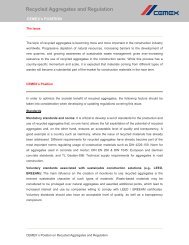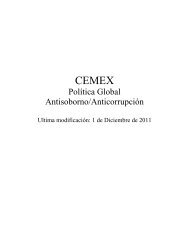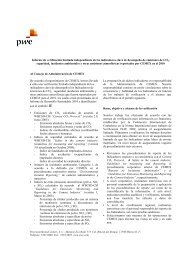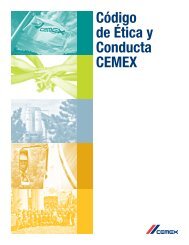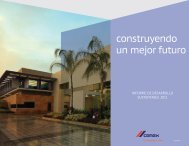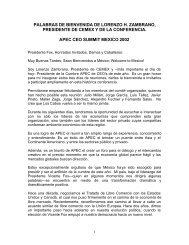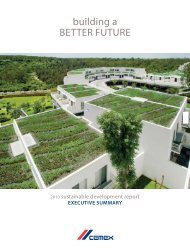building a STRONGER foundation - Cemex
building a STRONGER foundation - Cemex
building a STRONGER foundation - Cemex
Create successful ePaper yourself
Turn your PDF publications into a flip-book with our unique Google optimized e-Paper software.
Beginning on June 30, 2008, Ready Mix USA had a put option right, which, upon exercise, would require us to acquire Ready<br />
Mix USA’s interest in CEMEX Southeast, LLC and Ready Mix USA LLC at a price equal to the greater of a) eight times the<br />
companies’ operating cash flow for the trailing twelve months, b) eight times the average of these companies’ operating cash flow for<br />
the previous three years, or c) the net book value of the combined companies’ assets. On September 30, 2010, Ready Mix USA<br />
exercised its put option right. As a result, we will acquire Ready Mix USA’s interest in CEMEX Southeast, LLC and Ready Mix USA<br />
LLC, which have cement, aggregates, ready-mix and block assets located in the southeast region of the U.S. The acquisition will take<br />
place upon the closing of the transaction, which is expected in September 2011, after the performance of the obligations by both<br />
parties under the put option agreement. CEMEX’s purchase price for Ready Mix USA’s interests, including a non-compete and a<br />
transition services agreement, will be approximately U.S.$355 million. As of March 31, 2011, Ready Mix USA, LLC had<br />
approximately $23 million (unaudited) in net debt (debt minus cash and cash equivalents), which is subject to be consolidated upon<br />
closing of the transaction. Ready Mix USA will continue to manage Ready Mix USA, LLC, the joint venture in which it has a<br />
majority interest, until the closing of the transaction. As of December 31, 2010, CEMEX has not recognized a liability, as the fair<br />
value of the net assets exceeds the purchase price. Had the purchase price exceeded the fair value of the net assets acquired, a loss<br />
would have been recognized.<br />
On February 22, 2010, Ready Mix USA LLC completed the sale of 12 active quarries and certain other assets to SPO Partners &<br />
Co. for U.S.$420 million. The active quarries, which consist of two granite quarries in Georgia, nine limestone quarries in Tennessee,<br />
and one limestone quarry in Virginia, are operated by Ready Mix USA LLC and were deemed non strategic by CEMEX and Ready<br />
Mix USA LLC. The proceeds from the sale were partly used to reduce debt held by Ready Mix USA LLC, and to effect a cash<br />
distribution of approximately U.S.$100 million to each joint venture partner, including CEMEX.<br />
On September 18, 2007, we announced our intention to begin the permitting process for the construction of a 1.7 million ton<br />
cement manufacturing facility near Seligman, Arizona. The state-of-the-art facility will manufacture cement to serve the future growth<br />
of Arizona, including the Phoenix metropolitan area. As a result of current market conditions and consistent with the reduction of our<br />
expansion capital expenditure program, we have delayed the completion of this project. As of December 31, 2009, we had spent a<br />
total of approximately U.S.$14 million on this project, and we did not incur capital expenditures in 2010. We do not plan to incur<br />
capital expenditures in the construction of the Seligman Crossing Plant during 2011. During the first quarter of 2011, due to the low<br />
levels of construction activity and increased costs, we have implemented a minimum margin strategy in our Arizona operations,<br />
through the closure of under-utilized facilities, the reduction of headcount, among other actions pursuing improvement in the<br />
profitability of our operations in the region.<br />
In February 2006, we announced a plan to construct a second kiln at our Balcones cement plant in New Braunfels, Texas in<br />
order to increase our cement production capacity to support strong demand amidst a shortfall in regional supplies of cement. The<br />
production capacity of the Balcones cement plant was approximately 1.1 million tons per year. The construction of the new kiln,<br />
which was designed to increase our total production capacity in the Balcones cement plant to approximately 2.2 million tons per year,<br />
was completed in the third quarter of 2008, although minor expenditures were made in 2009 and 2010. We spent a total of<br />
approximately U.S.$373 million in the construction of this new kiln, including U.S.$27 million in 2006, U.S.$187 million in 2007,<br />
U.S.$147 million in 2008, U.S.$10 million in 2009 and U.S.$2 million in 2010.<br />
In October 2005, Rinker announced that it had commenced detailed plant engineering for the construction of a second kiln at the<br />
cement plant in Brooksville, Florida in order to increase the cement production capacity by 50%. The production capacity of the<br />
Brooksville South plant was approximately 0.7 million tons per year. The construction of the new kiln was completed in the third<br />
quarter of 2008, with minor expenditures made during 2009. We and Rinker together spent approximately U.S.$244 million in the<br />
construction of this new kiln, including U.S.$2 million in 2005, U.S.$58 million in 2006, U.S.$121 million in 2007, U.S.$58 million<br />
in 2008 and U.S.$5 million during 2009.<br />
With the acquisition of Mineral Resource Technologies, Inc. in August 2003, we believe that we achieved a competitive<br />
position in the fly ash market. Fly ash is a mineral residue resulting from the combustion of powdered coal in electric generating<br />
plants. Fly ash has the properties of cement and may be used in the production of more durable concrete. Mineral Resource<br />
Technologies, Inc. is one of the four largest fly ash companies in the United States, providing fly ash to customers in 25 states. We<br />
also own regional pipe and precast businesses, along with concrete block and paver plants in the Carolinas and Florida.<br />
The Cement Industry in the United States. Demand for cement is derived from the demand for ready-mix concrete and concrete<br />
products which, in turn, is dependent on the demand for construction. The construction industry is composed of three major sectors,<br />
namely, the residential sector, the industrial-and-commercial sector, and the public sector. The public sector is the most cement<br />
intensive sector, particularly for infrastructure projects such as streets, highways and bridges. While overall cement demand is<br />
sensitive to the business cycle, demand from the public sector is more stable and has helped to soften the decline in demand from the<br />
residential and industrial and commercial sectors during the current recession.<br />
45



